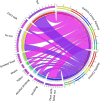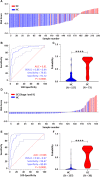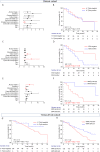Panel of significant risk factors predicts early stage gastric cancer and indication of poor prognostic association with pathogens and microsatellite stability
- PMID: 33568233
- PMCID: PMC7877109
- DOI: 10.1186/s41021-021-00174-6
Panel of significant risk factors predicts early stage gastric cancer and indication of poor prognostic association with pathogens and microsatellite stability
Abstract
Background: There are very few studies covering the epidemiological risk factors associated with Epstein Barr Virus (EBV) and Microsatellite stability for Gastric Cancer (GC) cases. Early diagnosis of GC through epidemiological risk factors is very necessary for the clinical assessment of GC. The aim of this study was to find out the major risk factors to predict GC in early stage and the impact of pathogen infection and MSI on survival rate of patients. GC samples were screened for Helicobacter pylori, Epstein Barr Virus, and Mismatch repair (MMR) gene status (microsatellite stable or instable). Chi-square and logistic regression analysis of Odd ratio and 95% confidence interval (OR, 95% CI) were performed to find out the association between epidemiological factors and the risk of gastric cancer. The pathogen and MMR gene status were analysed to predict their effect on overall survival and the risk score and hazard ratio was calculated for prognostic assessment.
Results: Excess body weight, consumption of extra salt, smoked food, alcohol, and smoking were the major risk factors for GC development. This study achieved a high area under the curve (AUC 0.94) for the probable GC patients in early-stage using the five-panel epidemiological risk factors. H. pylori infected cases were significant with smoked food, while EBV was found to be associated with tuibur intake and smoked food. In overall survival analysis EBV infected and microsatellite stable (HR: 1.32 and 1.34 respectively) GC cases were showing poor prognosis.
Conclusion: This study might provide new opportunities for personalized treatment options using this epidemiological factor risk score and clinicopathological factors assessment for early detection and prognosis in high-risk GC populations.
Keywords: Clinicopathological data; EBV; Gastric Cancer; H. pylori; MSI; Risk factors.
Conflict of interest statement
The authors declare that they have no competing interests.
Figures





References
Grants and funding
LinkOut - more resources
Full Text Sources
Other Literature Sources
Miscellaneous

